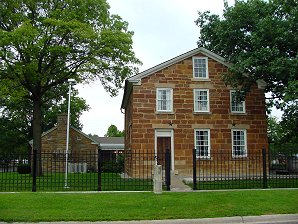| "For the word of the Lord is truth, and whatsoever is truth is light..." |
Carthage Jail by Donald L. Enders by Donald L. Enders
The old jail in the town of Carthage, Illinois, seat of Hancock County, was the site of the martyrdom of Joseph and Hyrum Smith on June 27, 1844, by a mob of approximately 150 men. Today it is a historical site of the Church and serves as a memorial to prophets of God who suffered martyrs' deaths. The jail was built in 1839. Constructed of native red limestone, the two-story rectangular gable-front building measures twenty-nine by thirty-five feet. Like other county jails in Illinois, Carthage Jail was built to incarcerate petty thieves and debtors and to serve as a temporary holding place for violent criminals. It housed a debtor's room in the northwest corner of the first floor, and a dungeon, or "criminal cell" on the second floor, north side. There was also a living area for the jailer's family that included a kitchen, a dining room, and bedrooms. The cells were dark and generally foul-smelling and had only meager makeshift furnishings. Joseph Smith, Hyrum Smith, and several other LDS leaders were incarcerated in Carthage Jail on June 25, 1844, to answer charges stemming from the destruction of the press used to print the anti-Mormon newspaper Nauvoo Expositor. During their three-day confinement they sought, through letters and personal appeals—even to the governor, then in Carthage—for an impartial resolution of the charges and for protection from people openly threatening their lives. They were first placed in "close confinement" in the dungeon. Later they were moved to the debtors' cell and then to the jailer's upstairs bedroom in the southeast corner. By midday of June 27, only the Smiths and John Taylor and Willard Richards of the Quorum of the Twelve Apostles remained confined in the jail. The governor had disbanded the militia, left the prisoners under guard of the Carthage Greys (known enemies of the Latter-day Saints), and gone to Nauvoo with a detachment of troops. Shortly after 5:00 p.m. a large force of armed men with blackened faces rushed the jail. Overcoming token resistance by the Greys, some of the mob entered the building, ascended the stairs to the landing just outside the upstairs bedroom, and commenced shooting into the room through the closed door. Hyrum Smith, patriarch to the church and associate President in the Church's First Presidency, was gunned down. John Taylor was critically wounded, but Willard Richards miraculously escaped injury (HC 6:561-622). The Prophet, shot from both inside and outside the jail as he prepared to leap from an upstairs window, fell to the ground dead, near a well. Carthage Jail served Hancock County until 1866. It was then a private residence, until the Church purchased it in 1903. Assisted by the Illinois Department of Public Works and Buildings, the Church completed a partial restoration of the jail in 1935. In 1989, on the 145th anniversary of the martyrdom, the Church completed a major renovation of the whole Carthage Jail block. The jail proper was restored to its 1844 condition, and the block was fenced, landscaped, and dressed with walks, monuments, and sculpture. The adjacent visitors center, enlarged to accommodate 150 people, now holds exhibits and a theater showing a film that portrays Joseph Smith's religious and spiritual experiences.
Bibliography Baker, LeGrand L. "On to Carthage to Die." IE 72 (June 1969):10-13, 15. McRae, Joseph A., and Eunice McRae. "Carthage Jail: A Physical Description of an Historical Structure." IE 45 (June 1942):372-73, 391.
|
||
|
Encyclopedia of Mormonism, Vol. 1, Carthage Jail Copyright © 1992 by Macmillan Publishing Company Photo courtesy of Wikipedia |
||